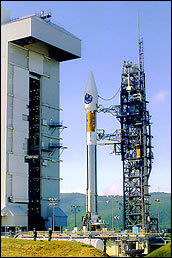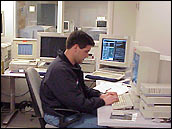

 |
|||
Launching satellites into orbit is never as simple as merely pushing the "ignition button" in the mission control room and letting computers do all the work. Inevitably, there are obstacles to overcome—some anticipated and some surprising—and valuable lessons to learn along the way. The launch and deployment of Terra was no exception. Mission managers had to work through several delays in the launch date as well as some "exciting" episodes once the spacecraft reached orbit, but, thanks to a well-prepared launch support team, the spacecraft is working beautifully and now gathering important Earth system data. Terra Project Manager Kevin Grady, at NASA’s Goddard Space Flight Center, shares some of the lessons he and his team learned along the way. |
|||
"It all begins with a launch support team that is resourceful and adept at identifying and solving problems quickly," says Grady. "But to launch a successful mission of this scope, you also need a robust spacecraft and a well-prepared flight operations team. Fortunately for Terra, we had both." Although the launch team consisted of seasoned personnel, some with decades of experience, Terra’s flight operations system was brand new and had never before been used in a NASA launch. This explains one of the launch slips. Terra was supposed to launch in December 1998, but mid-way through that year the mission managers realized that the flight operations software they had been developing just wasn’t going to get the job done. The EOS Science Data and Information System (ESDIS) Project decided to abandon that system and instead adopted another system that Raytheon Corporation was using for commercial launches. Of course, the new system had to be heavily modified to work in NASA’s Earth Observing System (EOS) mission operations environment. So, the launch was pushed back to July 1999 to allow time for the modifications. Then, as the summer of ’99 approached, a launch failure occurred on another vendor’s rocket, which used an engine nearly identical to the Atlas IIas rocket that would launch Terra. The engine was grounded until, after months of detailed examinations, Lockheed-Martin reported to NASA that Terra’s launch vehicle was cleared for flight. A new launch date was set for December 16, 1999. Those who work with him will tell you that Grady is the type of manager who tends to "see the glass as half full." Consider his advice to his team in the days leading up to Terra’s launch: "Spacecraft operations and activation will be full of opportunities to excel." His words proved prophetic. On the morning of December 16, Grady recalls, "I was a little anxious to get on with the launch. I wasn’t really nervous because I was pretty confident that we were well prepared." He didn’t know it yet but Terra would stand ready on the launch pad another 48 hours before lift off. To Launch or Not to Launch |
 After a long series of delays, Terra was ready for launch by December 16, 1999. However, a software glitch aborted the first launch attempt. (Photograph by NASA) | ||
On December 16 at 10:47 a.m. PST, the countdown came within 40 seconds of ignition of the Atlas rocket’s first stage engines when one of the "housekeeping" computers issued an "abort" command. Up to the time of launch, according to Grady, computers are cycling through hundreds of rocket status checks to continually monitor the health and readiness of the rocket to launch. An "out of limits condition" was reported by one of the computers at the T-40 second point, and the launch was scrubbed. The limit violation proved to be erroneous, and after a thorough examination by the Lockheed ATLAS engineers, the launch was rescheduled for Saturday. Grady says there was never any problem with the Terra spacecraft during this time. It remained powered up and perfectly responsive during the entire 48-hour delay. Terra only had a 30-minute launch window. Due to the fact that Terra has strict requirements for the timing of its orbit (to descend across the equator at 10:30 a.m. local time), the launch had to occur sometime between 10:30 and 11 a.m. PST. If mission managers missed this window for any reason, then the launch would have to be postponed until the next day. On the morning of December 18, as the launch window approached, so too did a high-pressure front from out over the Pacific Ocean, bringing high winds aloft. Atlas mission managers always monitor wind intensity on the day of launch by launching a series of balloons with gauges onboard to measure wind speed and direction at various altitudes up through the lower atmosphere. As Terra slipped later into its launch window, the Atlas engineers were carefully examining the winds aloft to determine whether the wind velocity exceeded the Atlas design limits. Just before the close of the window, the Atlas engineers gave a "go to launch." Dick Quinn, deputy program manager at Lockheed-Martin in charge of Terra launch operations, recalls feeling skeptical that the mission would launch that day. Quinn started working on the Terra Project in 1992. Not that he didn’t share Grady’s confidence. Quinn first began supporting NASA programs back during the Apollo missions. In his career, he supported the development of 21 Apollo lunar modules as well as a number of satellite missions. He has seen an evolution in the process of clearing a mission for launch. "After the Challenger accident, the way rockets go up nowadays is much more deliberate and slow-paced," he observes. "This is still the business of exploration. Terra is one of a kind, built from the ground floor up. That’s a lot different than launching the fifth or the fiftieth version of the same thing. "Even so," he states, "there was no way it wasn’t going to
work. We were ready." |
 Terra’s flight controllers were responsible for seeing the spacecraft safely into orbit. They also successfully guided Terra through a a series of surprises during activation of the spacecraft for science operations. (Photograph courtesy Terra Project) | ||
With only 10 seconds left in the launch window, the Atlas IIas rocket lifted off from the Vandenberg Air Force Base launch pad and began a picture-perfect ascent through the atmosphere, (view video [2.8MB]) carrying Terra--flagship of NASA’s Earth Observing System program--in its nose-cone (called a "fairing"). Three minutes later, the fairing separated from the rocket and carried its precious cargo into a low-Earth orbit, flying elliptically 655 km by 695 km above our planet. Four minutes after that, Terra’s transponders turned on and began sending data to mission control via NASA’s Tracking and Data Relay Satellite System (TDRSS). "Everything was happening pretty much as the ascent timeline called for," recalls Grady, "which gave us a good feeling. Then, when we received housekeeping data from TDRSS right on schedule, that was the confirmation that everything was proceeding on the mark. That was when we breathed our first sigh of relief." Fourteen minutes after launch, the Centaur (second stage) engine shut down and the spacecraft separated from the booster. Immediately, Terra’s Guidance Navigation and Control system oriented itself with respect to Earth and performed very well. Next came deployment of the solar array, without which the mission would have an extremely short lifetime. According to Grady, Terra’s was the most complicated solar array deployment in NASA’s history—all controlled by software. The solar array unfurled facing the Earth almost directly over Antarctica and worked so efficiently that it almost immediately gleaned about a kilowatt of power from the sunlight reflected off the bright, ice-covered surface. "At that point I was extremely happy," says Grady, "because we were charging the batteries and I knew the power system was working. All signs were pointing to a successful mission." Of course, Terra still had to be raised to its final orbital altitude of 705 km before science operations could begin. The data used in this study are available in one or more of NASA's Earth Science Data Centers. |
 Ten seconds before Terra's launch window closed, it soared into the clear sky over Vandenberg Air Force Base. Fourteen minutes after that, Terra was in orbit. (Photograph and video by NASA [2.8MB]) | ||